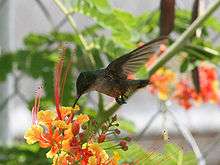Puerto Rican emerald
| Puerto Rican emerald | |
|---|---|
 | |
| Scientific classification | |
| Kingdom: | Animalia |
| Phylum: | Chordata |
| Class: | Aves |
| Order: | Trochiliformes |
| Family: | Trochilidae |
| Genus: | Chlorostilbon |
| Species: | C. maugaeus |
| Binomial name | |
| Chlorostilbon maugaeus (Audebert & Vieillot, 1801) | |
The Puerto Rican emerald (Chlorostilbon maugeaus), or zumbadorcito de Puerto Rico in Spanish, is an endemic hummingbird found only in the archipelago of Puerto Rico.
The species displays sexual dimorphism with males and females differing in coloration. The male has iridescent green feathers on its body and a black tail while the female has a white breast and white out tail feathers. They measure 9-10 cm and weigh about 3 grams. The species is found mainly in mountainous regions of Puerto Rico but also occurs along the southwest coast of the main island. Puerto Rican emeralds are highly territorial, often defending territories with intense aerial pursuits.
Puerto Rican emeralds use their long pointed bills and long tubular tongues to probe for insects, spiders and nectar, being especially attracted to red flowers. They can breed year-round but breeding is concentrated before the wet season starts from February to May. The female lays two tiny white eggs (measuring 8–13 mm) in a nest cup made of grasses and twigs. The male plays no part in the nesting process.
See also
- Fauna of Puerto Rico
- List of endemic fauna of Puerto Rico
- List of Puerto Rican birds
- List of Vieques birds
- El Toro Wilderness
References
- ↑ BirdLife International (2012). "Chlorostilbon maugaeus". IUCN Red List of Threatened Species. Version 2013.2. International Union for Conservation of Nature. Retrieved 26 November 2013.
- Oberle, Mark (2003). Las aves de Puerto Rico en fotografías (in Spanish). Editorial Humanitas. ISBN 0-9650104-2-2.
